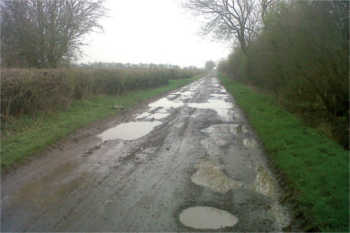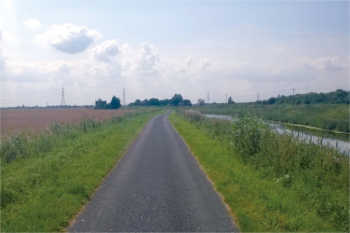Lincolnshire hasn’t had an easy ride with local road maintenance. Like many other rural areas, the county has to withstand considerable pressure on its unclassified road network. Yet the challenge of sustaining these routes has been exacerbated by a local soil type particularly prone to drought, which has proved devastating for regional routes.
In recent years tightening council budgets have been forced to also tackle droughts and severe winters, bringing with them the perils of ice damage and potholes. Over 2010/11, research suggests drought conditions caused damage to 154 local road sections.
The peat and clay based soils in much of Lincolnshire are recognised as being particularly susceptible to moisture related shrinkage. Traditional treatments have added more weight to hierarchy four and five roads, which are more susceptible to soil movement, freeze damage and thaws. Equally, overlay treatments designed to deal with deflections and cracking are known to result in dangerous undulations.
It took a particularly innovative approach to solve almost all of these problems in one swoop.

A Lincolnshire road before the new treatment

A Lincolnshire road after the treatment
In June 2013, Lincolnshire County Council secured £6.5m of central government funding to deal with highways damage caused by severe weather. Of this, £1m was allocated to the two-year Alliance retread programme – an in-situ road recycling process that is tackling many of the region’s key highways problems. Under the process, a milling machine pulverises existing material on the road’s top surface. A tractor then mixes the material, with the surface subsequently being harrowed and graded to form the new road profile.
A thick bitumen emulsion is then sprayed onto the surface, with a 10/14mm single size aggregate applied to fill surface voids before rolling takes place once again. A double application of binder and up to 6mm of surface dressing is finally applied to complete the procedure.
Richard Fenwick, highways engineer at Lincolnshire, says the method is definitely a step up from historic approaches in the region.
‘Cost wise, it’s probably similar to an overlay but it just a much better treatment. The results we’ve seen so far have shown you don’t add that weight in so you don’t then get the road immediately sinking again,’ Mr Fenwick says.
‘To start with, we weren’t really bringing in any extra imported material unless there were severe undulations but we have started to bring planings into the sites.
‘In the first part of the programme, we were doing a 75mm plane out, then scarification, and some more binder was worked in and it’s relayed. But we’ve started bringing material in to build an extra 25mm to the roads, which improves the structure,’ he adds.
Forecasts suggest the process will last for up to a decade and Mr Fenwick affirms surface dressing should prolong and maintain the work.
‘The year one sites look great,’ he emphasises. ‘The test of time will show how long we actually get out. If we get eight to 10 years, then they prove pretty cost effective. It was more of a cost saving method, and is probably the most efficient, cheapest method that’s been presented so far.’
While retread was originally designed for drought damaged roads, the process has also been able to deal with lateral cracking caused by deflections.
‘We had the years of drought but then with severe winters, the ice gets into that and you end up with potholes on the same road,’ Mr Fenwick says.
‘Data suggests a lot of the potholes we are trying to respond to are on our unclassified roads; so as well as giving a good shape to the road surface, this process is taking out all these potholes and giving a good closed surface texture. It’s solving two problems,’ he adds.
He says that while highways managers have had to focus on more major networks, the retread process has been welcomed as a route to cost-effectively repairing the frequent potholes that emerge on smaller routes.
‘Retread has been jumped on as a process of doing that and hopefully getting more life out of it for not too much cost,’ Mr Fenwick says.
Early projections outlined the need for surface dressing after a year. However, trials are underway on certain sites to see how long treated roads can last before action is taken.
Mr Fenwick affirms the tests have been ‘fairly successful’, with the texture on roads holding up without evidence of cracks. Alliance partner Kier procured sub-contractor Colas to undertake the on-site work, which has been completed at an average rate of 1,800sqm a day.
The plan for 2014 is no less ambitious, with another 25km of road network due to be treated under retread.
‘In a lot of these sites, they’re in and out and are getting a site done in a day - in some of the bigger sites, maybe two or three days,’ Mr Fenwick says.
This speed minimises road closures and disruption, which Mr Fenwick suggests can have a ‘big impact’ on the network and local economy.
Savings have chiefly been achieved thanks to the recycling of materials from other surfacing jobs across the county. Re-use of recycled materials from A and B roads has reduced disposal costs, while haulage spending has been slashed thanks to falls in sub-stances coming in – or travelling out of – the region.
Such benefits come hamd-in-hand with impressive environmental boons. Carbon emissions from material haulage have been reduced as fewer long trips are made on local roads. Alongside this, the retread process itself eliminates the need to remove potentially hazardous material containing road tar.
The procedure of cold mix recycling means tar bound material can be retained in the road structure, also cutting costly disposal costs, which can reach up to £100 per ton.
‘It’s just a case of streamlining the process and getting it working as efficient as possible around the country and using local depots; that is where a lot of savings can be made on haulage,’ Mr Fenwick says.
‘You are getting a big hit of our unclassified network being done each year, which ties into our asset management plan in terms of trying to maintain the degradation of our highways.’
Estimated costs for maintaining Lincolnshire CC’s hierarchy four and five roads– based on design manuals for 25-year life – were previously thought to stand at around £58 per square metre.
This figure included the cost of taking up the road surface, resurfacing and tar disposal.
Conversely, the cost of implementing retread is around £12 per square metre – a price that includes site visits every 12 years. On top of this, the process is also recognised as being more sustainable.
Nevertheless, Mr Fenwick emphasises the process is still ‘evolving’ and outlines some intriguing plans for the months ahead.
‘In this year’s programme we’ve got a built u